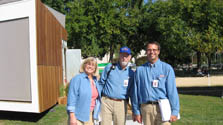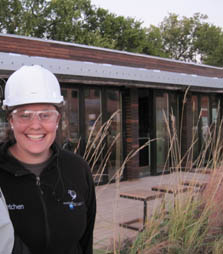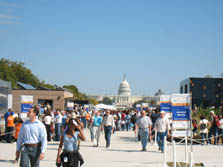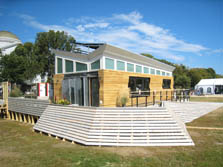
Click photo to view high-resolution image.

Market Viability jurors Joyce Mason, Paul Waszink, and James Ketter finish their evaluation of Team California's Refract House.
(Credit: Robin Ashmore/U.S. Department of Energy Solar Decathlon)

Gretchen Miller of Penn State is happy that her team's house is finally finished and ready for competition.
(Credit: Robin Ashmore/U.S. Department of Energy Solar Decathlon)

With the United States Capitol as a backdrop, enthusiastic crowds flock to the National Mall for the first day of public tours at the U.S. Department of Energy Solar Decathlon 2009.
(Credit: Richard King/U.S. Department of Energy Solar Decathlon)

The Meltwater house, designed and built by the University of Wisconsin-Milwaukee team, stands ready for visitors.
(Credit: Richard King/U.S. Department of Energy Solar Decathlon)
Solar Decathlon 2009
Daily Journal - October 9, 2009
Teams Rally Together in True Solar Decathlon Spirit
Glorious weather provided a brilliant, sunny day for the first day of public tours, and three juries—Architecture, Market Viability, and Communications—began subjective evaluations.
We finally have all 20 teams finished. I really appreciate the spirit of collaboration and camaraderie that the Solar Decathlon teams demonstrated to bring the last two houses on line for the competition. Both Penn State and the University of Wisconsin-Milwaukee faced issues that delayed their starts. For the latter, a tall roof was unable to clear several bridges, and, although the piece was ultimately delivered, time was lost with a major detour. Penn State encountered problems with its electrical wiring and a ramp that had to be transformed into a commercial-grade staircase. Electrical experts from the Milwaukee team extended a hand to help Penn State resolve its wiring issues. In a gesture of reciprocity, half of the Penn State team helped clean up the Milwaukee site. The Penn State students soon realized that they were a bit shorthanded for their own clean-up. Not to worry. Neighbors from Team Kentucky stepped up to the plate to help get Penn State ready.
The Architecture, Market Viability, and Communications contests put a total of 275 potential points on the line. Students are paying close attention to final details that might affect their scores. The Architecture Jury evaluates the architectural elements of the house, the extent to which a holistic design approach is incorporated, and the inspiration behind the architectural execution. The Market Viability jury is assessing curb appeal and asking the fundamental question of how well each house might fare in the open market. Finally, the Communications Jury awards points for effective delivery, clarity, and consistency of messages to the public regarding house technologies and team experiences.
We're all pleasantly surprised by the enthusiastic visitors today. Team Ontario/BC recorded 75 visitors in the first two minutes of opening! We'll see what the weekend brings to this intriguing street of solar energy homes, but if our initial turnout is any indication, we can expect a steady flow of people interested in learning more about solar and energy-efficient technologies. The teams are excited, and the competition is heating up as we head into a second day of jury evaluations.
